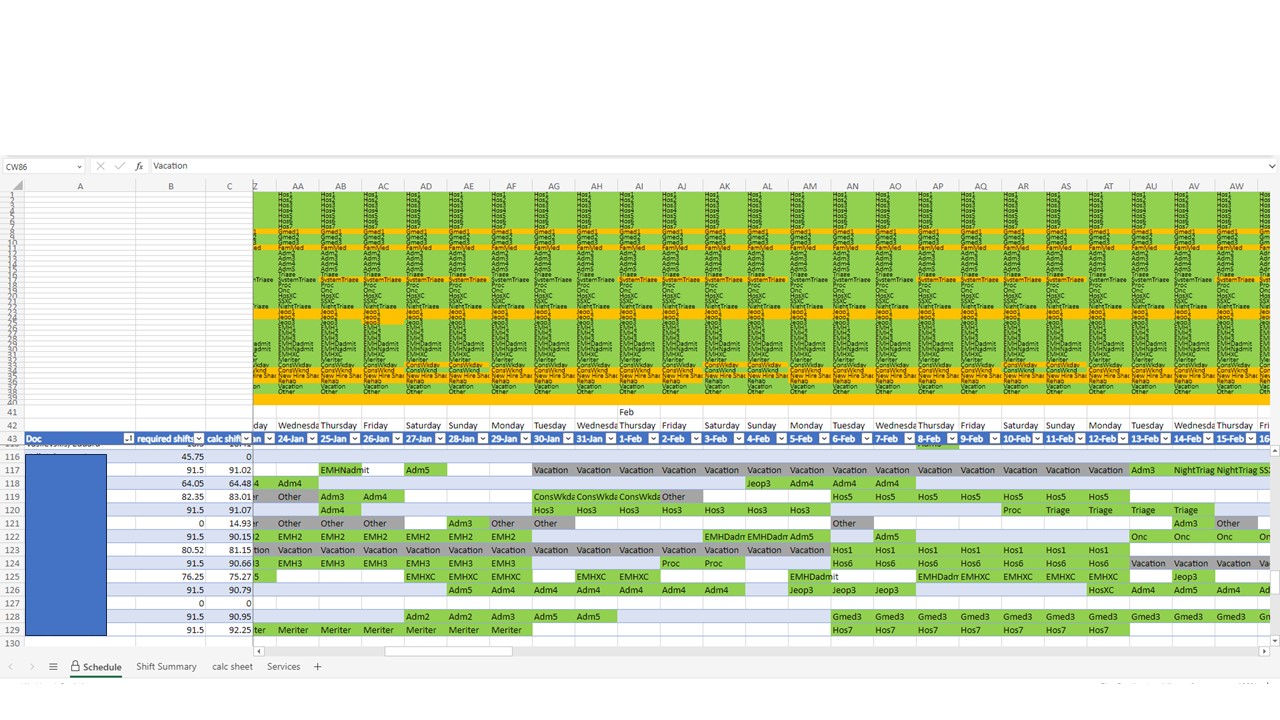Background: Prior to Jul 2023, at our academic hospital medicine program, the 6-month clinical schedule was created in commercial scheduling software and released 2-4 weeks before the start of that schedule. The actual schedule creation took 3+ months. This led to physician discontent due to the inability to plan professional and personal obligations. Our schedule is complex with 72 physicians and 31 different service lines that we staff daily – at total of >2000 potential combinations per day. Adding to the complexity, our physicians are paid per shift rather than salaried. As a result, shifts have variable FTE weights. Our physicians also have various administrative, education or leadership roles, and thus, differing clinical FTE (cFTE). The commercial scheduling software does not allow for simultaneous viewing of the shifts filled, physicians available and their total scheduled cFTE, making schedule creation arduous when using that software.
Purpose: We created a new scheduling tool that vastly improved the scheduling process which allowed for much earlier publication of the schedule.
Description: We identified that the commercial scheduling software was unsatisfactory and did not allow for viewing of all variables simultaneously. Two of the authors built a new Excel-based scheduling tool. The tool allows for simultaneous viewing on the Y axis of the doctors, their individual target cFTE, and their calculated cFTE which live tallies as shifts are added. Along the x-axis is the calendar and above the calendar are columns of the clinical shifts that must be filled per day. To build the schedule, we click a cell in the row associated with someone’s schedule for the particular day and select from a drop-down box to pick the shift; once that shift is used, the color on the shift list changes from orange to green, indicating the shift has been filled. The background tabs that operate the sheet include a cFTE calculator where individual’s total FTE is calculated based on the assigned shift weights, and there is also a tab that tracks accidental duplicate scheduling. The ability to immediately know current scheduled cFTE enabled us to quickly rectify over- or under-scheduling by redistributing shifts. We were also able to quickly identify areas of inequity if people were scheduled for above average night shifts, or above average weekend shifts. When we were informed of last minute changes (FMLA requests, cFTE changes, additional physicians starting mid-year), it was quite easy to edit multiple individual schedules quickly using our tool. Two of the authors completed the Jul-Dec 2023 schedule in about 3 weeks, publishing it in early April; and completed the Jan-Jun 2024 schedule in about 2 weeks, publishing it in early October.
Conclusions: We designed and implemented a new, Excel-based scheduling tool for our academic hospital medicine schedule of 72 physicians. This improved the scheduling process and speed at which the schedule was generated. In this process, we were able to honor all scheduling requests and generate a complex clinical schedule about 3 months before the schedule starts. The feedback from our division has been overwhelmingly positive since this change has occurred. Our future goals include copyrighting the sheet, dissemination to both local divisions and departments at our institution, as well as national dissemination to other hospitalist groups.

